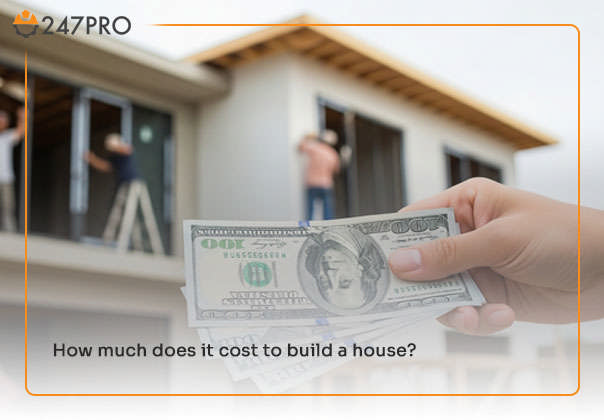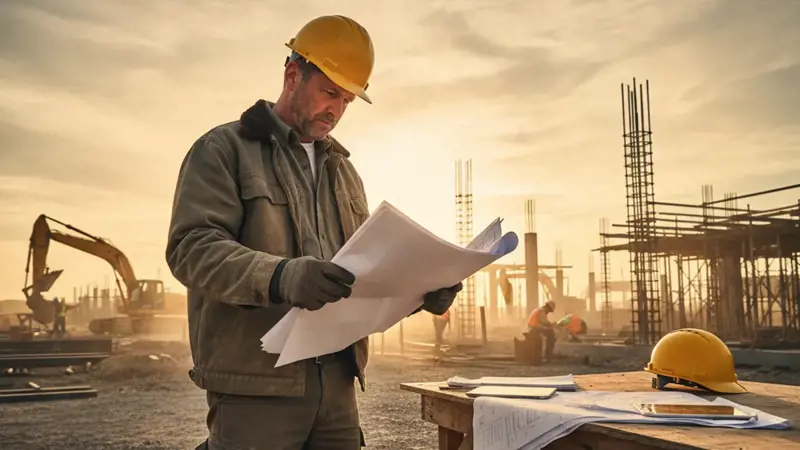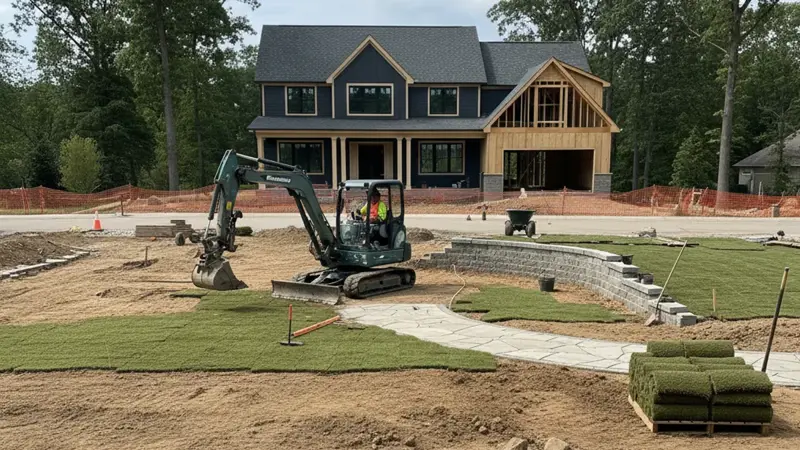Building a house is a significant investment, and understanding the costs involved and the financial aspects is the most crucial part of it. From the initial concept to the final touches, numerous factors contribute to the overall cost of building a house. Some of these factors include size. Materials, labor. And project type. Generally speaking, in the US, a mid-range build with standard characteristics would cost between $300,000 and $600,000.
In this guide, we provide a comprehensive overview of home building costs in 2025, breaking down and explaining each factor that influences home building, along with average figures and key considerations to help you budget effectively for your dream home. For precise estimates tailored to your budget, we highly recommend using 247pro’s Home Building Estimator.
Average cost to build a house in 2025
As of 2025, the average cost to build a house in the U.S. ranges from $100 to $400 per square foot for custom-built homes, excluding land costs. However, the final home building costs are influenced by location, size, materials, design complexity, labor rates, and unexpected issues.
Cost per Square Foot to Build a House
For a typical home, the average cost per square foot to build a house falls into three categories based on the complexity:
- Basic: Houses with simple designs and standard materials would cost $100 – $150 per square foot.
- Mid-Range: In such houses, the owner has the freedom to customize some features, and mid-grandee finishes are used. Generally, they would cost between $150 and $300 per square foot.
- Luxury: These are houses featuring premium materials, smart home systems, high-end fixtures, and a completely customized design. They generally cost $300 – $400 per square foot.
Another factor that can impact the cost per square foot is the regional variations:
- Urban areas typically cost $200 – $400 per square foot or more.
- Suburban areas are generally more affordable, with costs ranging from $150 to $250 per square foot.
- Rural areas: These areas would cost $100 – $200 per square foot.
Note that these figures exclude land cost, which varies significantly by region. Cost also depends on regional factors, such as local regulations, labor costs, and building codes.

How Much Does It Cost to Build a House by Size?
The size of your home is one of the most significant factors in determining the total cost of building a house. Laeger House requires more materials, labor, and time, which can lead to higher expenses. Below is a general breakdown of average costs by square footage for new construction in 2025:
For a deeper dive into how size can impact the total cost in your region, consider using our Home Building Estimator.
How Much Does It Cost to Build a Tiny Home?
Tiny homes have gained immense popularity for their affordability and minimalist lifestyle. They are generally 100–400 sq. ft., and the cost to build a tiny home is significantly lower than that of a traditional one. The cost per square foot of these homes is around $150–$250, and the general cost would vary based on the following factors:
- DIY Tiny Home: If you manage to build one on your own with basic materials, it would cost around $25,000 - $50,000
- Professionally Built: This will include the labor cost, and higher-quality materials will be used. So, the final cost would be around $60,000 to $150,000+
These costs generally cover the structure, basic utilities, and interior finishes. Custom designs or premium materials will increase the price. For a comprehensive guide on planning and budgeting for your tiny dream, get help from a professional consultant in the industry.
Building Slab Cost
Among the effective choices for a building’s foundation, a concrete slab is one of the most common ones, especially in warmer regions. The building slab cost includes the cost of excavation, grading, vapor barrier, rebar, and the concrete itself. The average cost for a concrete slab foundation in the U.S. ranges from $7 to $15 per square foot.
- A standard 2,000 Sq. Ft. Home in the U.S. would cost $14,000 to $30,000
Some other factors, such as soil condition, reinforcement, and slab thickness, can increase this price:
- Reinforcement: The cost ranges from $1 to $2 per square foot for rebar or mesh.
- Site Preparation: Soil testing, extra grading, or excavation would incur an additional cost of $2,000 to $10,000.
- Frost-protected slabs would cost more in colder climates, ranging from $8 to $12 per square foot.
Cost to Build a Duplex
A duplex building consists of two-unit homes, typically ranging from 2,000 to 3,000 sq. ft. It is a popular investment that offers the potential for rental income or multi-generational living. Costs in 2025 range from $200,000 to $600,000 or more:
- Basic Duplex: The cost would be $100 to $150 per square foot.
- Mid-Range Duplex: With some customization features and better materials, it would cost $150 to $200 per square foot.
- A luxury duplex, featuring the ultimate in quality materials and a fully customized design, would cost $200 to $400 per square foot or more.
Duplex buildings are generally larger in total square footage compared to a single-family home, due to the requirement of two separate utilities, bathrooms, or even kitchens. Another vital thing to bear in mind is that for a duplex building, you may need special permits and adhere to specific regulations, which can cost between $1,000 and $10,000.
How Much Does It Cost to Build a Cabin?
A cabin, typically ranging from 500 to 1,500 sq. ft., is a perfect option for vacationers and those dreaming of a rustic retreat. Cabins are generally more cost-effective than a full-sized home due to their simpler design, smaller size, and often simpler materials used in their construction; however, prices can still vary. Generally, the cost to build a cabin ranges from $50,000 to $225,000:
- Basic Kit Cabin (DIY): if you manage to build the cabin on your own with the most basic materials and design it, it would cost $25,000 - $75,000
- Custom-Built Cabin: Hiring professionals to build a cabin with a customized design and additional features typically ranges from $75,000 to $250,000.
Other factors can also increase this cost. For example, locations such as remote or mountainous regions will incur higher costs due to the difficulty of transporting materials and labor, as well as the challenging working conditions. The type of materials you choose is another factor in building a cabin.
Cost to Build a Frame House
A frame house, typically wood-framed, features a unique and appealing design with its own set of construction costs. The average cost to build a frame house in the U.S. as of 2025 can range $25,000 to $100,000 for the shell, while a fully custom-built house might cost between $150,000 and $400,000+, depending on size, location, and interior finishes. As you might guess, the costs of these houses are slightly higher than those of traditional homes due to the specialized framing.
Costs included here are as follows:
- Framing: $8–$15 per sq. ft.
- Sheathing and Siding: $4–$12 per sq. ft.
- Labor: $50,000–$100,000 for framing and exterior work.
So, in general, based on the complexity and design of the place, a frame house would cost like this:
- Basic: $100–$150 per sq. ft.
- Mid-Range: $150–$225 per sq. ft.
- Luxury: $225–$300+ per sq. ft.
Cost to build an apartment building
Understanding the cost to build an apartment building is crucial, as creating such structures is a more complex process that involves multi-story construction, commercial-grade systems, extensive permitting, and significant economies of scale. On average, the cost to build an apartment building ranges from $100 to over $ 300 per square foot, depending on size and quality:
- A Small Apartment Building with 4 to 8 units and approximately 5,000 sq. ft. would cost between $500,000 and $1,500,000.
- A Mid-Sized Building with 10 to 20 units (15,000 sq. ft.) would cost between $1.5 million and $4.5 million.
- High-end buildings with over 20 units will cost between $3,000,000 and $ 10,000,000 or more.
Key factors include the number of units, building height, material quality, and land acquisition costs. Building an apartment building requires detailed planning, a detailed budget, and a project coordinator for construction.
Labor Cost to Build a House
The labor cost to build a house is a significant part of your budget and typically accounts for 30% to 50% of the total cost. Labor rates vary by region, demand, and the complexity of the work.
- General Labor would get paid $15–$50 per hour.
- Skilled trades, such as electricians and plumbers, demand higher fees and typically earn $40 to $100 per hour.
- Urban Areas have higher rates due to higher demand and living expenses.
- Rural Areas have lower rates, but skilled labor may be less available.
Understanding how to manage and negotiate labor costs is crucial for staying within budget. Therefore, it is advisable to seek help from a reputable builder recruitment agency to find the best workers for your project, taking into account your budget and project needs.
Cost of Building a House vs Buying
Deciding between buying a house and building one has always been a tricky choice. Both of them have their advantages and disadvantages. We will cover some, but the decision is yours to make.
Buying a House:
- Pros
- Generally, buying a house will be less expensive than building one with the same characteristics.
- Buying a house and moving in is a much quicker process, typically taking 1 to 3 months at most
- Cons
- You have limited customization opportunities
- Buying an existing home usually comes with potential repair and renovation, especially older systems that will require updates.
Building a House
- Pros
- You have full customization and design control
- You can use modern and energy-efficient materials that can save energy costs later.
- Cons
- It involves a significant time commitment, around 6 to 18 months
- It requires a higher initial investment and land costs
- You might face unexpected expenses
Buying a house is often cheaper than building one, but the long-term value, energy efficiency, and tailored design of building a home can make it a worthwhile investment.
Buying a house is often cheaper than building one, but the long-term value, energy efficiency, and tailored design of building a home can make it a worthwhile investment.
Budgeting Smarter: Key Factors Influencing Your Home Building Costs
Beyond the specific components, several factors can significantly influence your cost of building a house:
- Land Costs: This is often excluded in construction estimates. Factors such as location, size, zoning, and site conditions can impact the land price. If you own the land, you can save thousands of dollars.
- Location: Urban areas have higher demand, labor rates, and material costs compared to rural areas. Another factor related to location is the mandatory permits, which vary significantly by municipality.
- Material Choices: The type of material you choose for your project can significantly impact the costs, as the materials are usually the most expensive part of the project. Your selections for flooring, cabinetry, countertops, windows, and exterior siding will have a considerable impact on the total cost of building a house.
- Design Complexity: simple designs are generally cheaper to build compared to homes with multiple angles, complex rooflines, numerous dormers, or intricate architectural features. Also, custom designs require more specialized labor and materials.
- Site Preparation: If your land is not in good condition, for example, the soil is poor or it requires extensive clearing and grading, the final cost of the project will go up.
- Permits and Fees: Mandatory permits are an essential part of budgeting, as this aspect is often neglected. You should research and determine what permits and regulations are required by your local authority.
- Unexpected Issues & Contingencies: Building a new home often encounters unanticipated financial issues that can have a negative impact on the budget. The best way to overcome them is to have a contingency fund, which is 10 to 20% of your total project cost, to cover these unexpected expenses.
From Estimate to Reality: Managing Your Home Building Budget
Here are some practical tips for managing your building budget:
- Get Multiple Detailed Bids: Always obtain multiple, detailed bids from at least three reputable contractors and compare them to get he best one. Remember that the cheapest bid is not always the best one.
- Choose Cost-Effective Materials: Cost-effective materials are not always the cheapest ones. Carefully examine the long-term effect of the materials you want to use to prevent expenses for repair or renovation later. Additionally, eco-friendly materials will help reduce future energy bills.
- Manage Materials: Always schedule material delivery to arrive on time at your work site; doing so will help you save on storage costs and prevent material damage and theft.
- Track Expenses Meticulously: Monitor the project constantly and keep detailed records of all expenditures, invoices, and payments. This will help you detect any financial problem at the earliest stage and prevent further damage.
- Research Permits Early: Before starting work, research local zoning and building codes to avoid potential delays and ensure compliance.
Building a house is a rewarding experience that can result in a home perfectly tailored to your needs and desires. By carefully understanding the costs involved in this process and being prepared to manage them effectively, you will ensure a successful project. Don’t forget that the fees mentioned in their text are average and based on the 2025 market. The actual cost may vary based on your location, site conditions, contractor rates, and market shifts. For a more accurate estimate, consult licensed contractors and local authorities for guidance.


